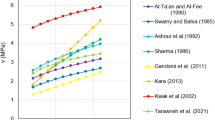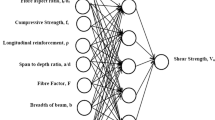Abstract
Incorporating steel fibers to the concrete members enhances the shear capacity. The shear capacity of steel fiber reinforced concrete (SFRC) beams is an important issue for designing the reinforced concrete structures. Due to numerous parameters that affect the shear capacity of SFRC beams, developing an exact equation to measure the shear resistance of SFRC beams is complicated. To present a more exact equation for shear capacity assessment of SFRC beams, compare to existing formulae the artificial neural networks (ANNs) developed. A series of reliable experimental data collected from the literature. A model-based ANN method for presenting an exact empirical formula developed. The accuracy of the developed formula is verified using several criteria, and a comparison study was carried out between the experimental data and the existing equations. It is understood that the obtained formula gives the most exact result among others. A sensitivity analysis based the Garson’s algorithm was executed to identify the most efficient variables.










Similar content being viewed by others

References
Tan KH, Murugappan K, Paramasivam P (1992) Shear behavior of steel fiber reinforced concrete beams. ACI Struct J 89(6):3–11
Lim TY, Paramasivam P, Lee SL (1987) Shear and moment capacity of reinforced steel-fiber-concrete beams. Mag Conc Res 39(140):148–160
Li VC, Ward R, Hamza AM (1992) Steel and synthetic fibers as shear reinforcement. ACI Mater J 89(5):499–508
Narayanan R, Darwish IYS (1987) Use of steel fibers as shear reinforcement. ACI Struct J 84(3):216–227
Narayanan R, Darwish IYS (1988) Fiber concrete deep beams in shear. ACI Struct J 85(2):141–149
Mansur MA, Ong KCG, Paramasivam P (1986) Shear strength of fibrous concrete beams without stirrups. J Struct Eng ASCE 112(9):2066–2079
Swamy RN, Bahia HM (1985) Effectiveness of steel fibers as shear reinforcement. Concr Int Design Constr 7(3):35–40
Murty DSR, Venkatacharyulu T (1987) Fiber reinforced concrete beams subjected to shear force. In: Proceedings of the international symposium on fiber reinforced concrete. Madras, India. pp 1125–1132
Ashour SA, Hasanain GS, Wafa FF (1992) Shear behavior of high strength fiber reinforced concrete beams. ACI Struct J 89(2):176–184
Balazs GL, Kovacs I (2000) Flexural behaviour of RC and PC beams with steel fibre. In: Proceedings of the international workshop on structural application of steel fibre reinforced con crete. Politecncio of Milan, Milan. pp 85–92
Furlan S, De Hanai JB (1997) Shear behaviour of fiber reinforced concrete beams. Cem Concr Compos 19(4):359–366
Dinh HH, Parra-Montesinos GJ, Wight JK (2010) Shear behavior of steel fiber reinforced concrete beams without stirrup reinforcement. ACI Struct J 107(5):597–606
Shin SW, Oh J, Ghosh SK (1994) Shear behavior of laboratory sized high-strength concrete beams reinforced with bars and steel fibers, fiber reinforced concrete developments and innovations, SP 142. American Concrete Institute, Farmington Hills, pp 181–200
Greenough T, Nehdi M (2008) Shear behavior of fiber-reinforced self-consolidating concrete slender beams. ACI Mater J 105(5):468–477
Imam M, Vandewalle L, Mortelmans F (1994) Shear capacity of steel fibre concrete beams. In: Malhotra M (ed) Proceedings of ACI international conference on high-performance-concrete. ACISP-149, Singapore, pp 227–243
Adebar P, Mindess S, Pierre D, Olund B (1997) Shear tests of fiber concrete beams without stirrups. ACI Struct J 94(1):68–76
Kwak YK, Eberhard MO, Kim WS, Kim J (2002) Shear strength of steel-fibre-reinforced-concrete beams without stirrups. ACI Struct J 99(4):530–538
Batson G, Jenkins E, Spatney R (1972) Steel fibers as shear reinforcement in beams. ACI J Proc 69(10):640–644
Cucchiara C, Mendola LL, Papia M (2004) Effectiveness of stirrups and steel fibers as shear reinforcement. Cem Concr Comp 26:777–786
Cho S, Kim Y (2003) Effects of steel fibers on short beams loaded in shear. ACI Struct J 100(6):765–774
Sharma AK (1986) Shear strength of steel-fibre-reinforced-concrete beams. ACI Struct J 83(4):624–628
Rosenbusch J, Teutsch M (2003) Shear design with (σ − ε)method. In: Proceedings of the international RILEM workshop on test and design methods for steel fiber reinforced concrete. RILEM Publications SARL, Bochum, pp 105–17
Hockenberry T, Lopez MM (2012) Performance of fiber reinforced concrete beams with and without stirrups. J Civil Environ Arc Eng 4(1):1–11
Hwang J, Lee D, Kim K, Ju H, Seo S (2013) Evaluation of shear performance of steel fibre reinforced concrete beams using a modified smeared-truss model. Mag Concr Res 65(5):283–296
Campione G, La Mendola L, Papia M (2006) Shear strength of steel fiber reinforced concrete beams with stirrups. Struct Eng Mech 24(1):107–136
Al-Ta’an Al-Feel SAJR (1990) Evaluation of shear strength of fibre-reinforced concrete beams. Cem Concr Compos 12(2):87–94
Khuntia M, Stojadinovic B, Goel SC (1999) Shear strength of normal and high strength fiber reinforced concrete beams without stirrups. ACI Struct J 96(2):282–289
Gandomi AH, Alavi AH, Yun GJ (2011) Nonlinear modeling of shear strength of SFRC beams using linear genetic programming. Struct Eng Mech 38(1):1–25
Fatih Kara I (2013) Empirical modeling of shear strength of steel fiber reinforced concrete beams by gene expression programming. Neur Comput Appl 23:823–8348
Khaloo AR, Kim N (1997) Influence of concrete and fiber characteristics on behavior of steel fiber reinforced concrete under direct shear. ACI Mater J 94(6):592–601
Shin SW, Oh JG, Ghosh SK (1994) Shear behavior of laboratory-sized high strength concrete beams reinforced with bars and steel fibers symposium paper 142:181–200
Kwak Y, Eberhard MO, Kim W, Kim J (2002) Shear strength of steel fiber-reinforced concrete beams without stirrups. ACI Struct J 99(4):530–538
Narayanan R, Darwish IYS (1988) Fiber concrete beams in shear. ACI Struct J 85(2):141–149
Ahmadi M, Kheyroddin A, Dalvand A, Kioumarsi M (2020) New empirical approach for determining nominal shear capacity of steel fiber reinforced concrete beams. Constr Build Mater 234:117293
Naderpour H, Haji M, Mirrashid M (2020) Shear capacity estimation of FRP-reinforced concrete beams using computational intelligence. Struct 28:321–328
Adhikary BB, Mutsuyoshi H (2006) Prediction of shear strength of steel fiber RC beams using neural networks. Constr Build Mater 20(2):801–811
Tohidi S, Sharifi Y (2015) Neural networks for inelastic distortional buckling capacity assessment of steel I-beams. Thin-Walled Struct 94(9):359–371
Tohidi S, Sharifi Y (2014) A new predictive model for restrained distortional buckling strength of half-through bridge girders using artificial neural network. KSCE J Civ Eng 10(3):325–350
Tohidi S, Sharifi Y (2014) Inelastic lateral-torsional buckling capacity of corroded web opening steel beams using artificial neural networks. IES J Part A: Civ Struct Eng 8(1):24–40
Sharifi Y, Tohidi S (2014) Lateral-torsional buckling capacity assessment of web opening steel girders by artificial neural networks–elastic investigation. Front Struct Civ Eng 8(2):167–177
Sharifi Y, Tohidi S (2014) Ultimate capacity assessment of web plate beams with pitting corrosion subjected to patch loading by artificial neural networks. Adv Steel Const 10(3):325–350
Tohidi S, Sharifi Y (2014) Load-carrying capacity of locally corroded steel plate girder ends using artificial neural network. Thin Walled Struct 100(1):48–61
Tohidi S, Sharifi Y (2015) Empirical modeling of distortional buckling strength of half-through bridge girders via stepwise regression method. Adv Struct Eng 18(9):1383–1397
Sharifi Y, Hosseinpour M (2019) Adaptive neuro-fuzzy inference system and stepwise regression for compressive strength assessment of concrete containing metakaolin. Int J Optimization Civ Eng 9(2):251–272
Sharifi Y, Lotfi F, Moghbeli A (2019) Compressive strength prediction by ANN formulation approach for FRP confined rectangular concrete columns. J Rehabil Civ Eng 7(3):182–203
Sharifi Y, Moghbeli A, Hosseinpour M, Sharifi H (2019) Neural networks for lateral torsional buckling strength assessment of cellular steel I-beams. Adv Struct Eng 22(9):2192–2202
Sharifi Y, Moghbeli A, Hosseinpour M, Sharifi H (2019) Study of neural network models for the ultimate capacities of cellular steel beams. Iran J Sci Technol Trans Civ Eng. https://doi.org/10.1007/s40996-019-00281-z
Sharifi Y, Hosseinpour M, Moghbeli A, Sharifi H (2019) Lateral torsional buckling capacity assessment of castellated steel beams using artificial neural networks. Int J Steel Struct 19:1408–1420
Sharifi Y, Mohammadi N, Moghbeli A (2018) Shear capacity assessment of reinforced concrete deep beams using artificial neural network. J Concr Struct Mat 3(5):30–43
Hosseinpour M, Sharifi H, Sharifi Y (2018) Stepwise regression modeling for compressive strength assessment of mortar containing metakaolin. Int J Model Simul. https://doi.org/10.1080/02286203.2017.1422096
Hosseinpour M, Sharifi Y, Sharifi H (2020) Neural network application for distortional buckling capacity assessment of castellated steel beams. Struct 27:1174–1183
Sharifi Y, Hosseinpour M (2020) Compressive strength assessment of concrete containing metakaolin using ANN. J Rehabil Civ Eng 8(4):15–27
Sharifi Y, Moghbeli A (2019) Stepwise regression for shear capacity assessment of steel fiber reinforced concrete beams. J Rehabil Civ Eng 7(2):95–108
Sharifi Y, Mohammadi N, Moghbeli, (2020) Artificial neural network for Shear Strength assessment of slender reinforced concrete beams without stirrup. J Iranian Soc Civ Eng 21(55):54–63
Sharifi Y, Moghbeli A (2020) New predictive models via gene expression programming and multiple nonlinear regression for SFRC beams. J Mat Res Tech 9(6):14294–14306
Sharifi Y, Moghbeli A (2020) New empirical approaches for compressive strength assessment of CFRP confined rectangular concrete columns. Compos Struct, Available online 28:113373
Moghbeli A, Sharifi Y (2021) New predictive equations for lateral-distortional buckling capacity assessment of cellular steel beams. Struct 29:911–923
Hristev RM (1998) The ANN book. GNU public license
Frank IE, Todeschini R (1994) the data analysis handbook. Elsevier, Amsterdam
Hagan MT, Menhaj MB (1994) Training feed forward networks with the Marquardt algorithm. IEEE Trans Neural Netw 5(6):861–867
Marquardt D (1963) An algorithm for least squares estimation of non-linear parameters. J Soc Ind Appl Math 11:431–441
Smith GN (1986) Probability and statistics in civil engineering. Collins, London
Garson GD (1991) Interpreting neural-network connection weights 47:51
Author information
Authors and Affiliations
Corresponding author
Ethics declarations
Conflict of interest
All authors declare that they have no conflicts of interest.
Rights and permissions
About this article
Cite this article
Sharifi, Y., Moghbeli, A. Shear capacity assessment of steel fiber reinforced concrete beams using artificial neural network. Innov. Infrastruct. Solut. 6, 89 (2021). https://doi.org/10.1007/s41062-021-00457-5
Received:
Accepted:
Published:
DOI: https://doi.org/10.1007/s41062-021-00457-5



